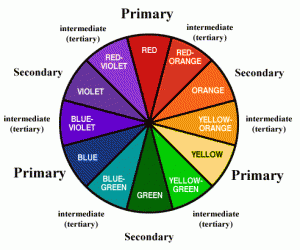Color Theory Terminology
The Color Wheel – A visual representation of colors arranged according to their chromatic relationship.
Primary Colors – Red Yellow and Blue. With these three colors (and black and white) all other colors can be made. The primary colors themselves can not be made by mixing other colors.
Secondary Colors – Those colors which are created by the mixture of two primary colors in approximately equal proportions. The secondary colors are orange, violet and green.
Tertiary Colors – Colors created by the mixture of an adjacent primary and secondary color. The tertiary colors are named by combining the names of the two parent colors, with the primary element listed first: orange + red = red-orange.
Complimentary colors – The colors opposite on the color wheel: red&green, blue&orange, yellow&violet
Hue – pure color
Value – The natural lightness or darkness of a hue or the amount of white or black in a color, pink is a light value of red, navy-blue is a dark value of blue, etc. (The lightness or darkness of a color).
Temperature – the warmth or coolness of a color
Warm Colors – Red, Orange, Yellow (sunny colors or fire colors)
Cool Colors – Violet, blue, green (water, sky)
Saturation – The dominance of hue in the color.
Intensity – The purity of a hue. A hue at its highest intensity has no other color mixed with it. A hue loses its intensity as another color is added to it.
Color in Context – The relationship of values, saturations and the warmth or coolness of respective hues can cause noticeable differences in our perception of color. The characteristic of a color can be manipulated according to its placement.
Color Wheel
A color circle, based on red, yellow and blue, is traditional in the field of art. Sir Isaac Newton developed the first circular diagram of colors in 1666. Since then, scientists and artists have studied and designed numerous variations of this concept. Differences of opinion about the validity of one format over another continue to provoke debate. In reality, any color circle or color wheel which presents a logically arranged sequence of pure hues has merit.
Primary Colors: Red, yellow and blue
In traditional color theory (used in paint and pigments), primary colors are the 3 pigment colors that cannot be mixed or formed by any combination of other colors. All other colors are derived from these 3 hues.
Secondary Colors: Green, orange and purple
These are the colors formed by mixing the primary colors.
Tertiary Colors: Yellow-orange, red-orange, red-purple, blue-purple, blue-green & yellow-green
These are the colors formed by mixing a primary and a secondary color. That’s why the hue is a two word name, such as blue-green, red-violet, and yellow-orange.
Color Context
How color behaves in relation to other colors and shapes is a complex area of color theory. Compare the contrast effects of different color backgrounds for the same red square.

Red appears more brilliant against a black background and somewhat duller against the white background. In contrast with orange, the red appears lifeless; in contrast with blue-green, it exhibits brilliance. Notice that the red square appears larger on black than on other background colors.
To learn more I would recommend checking out this website: https://www.colormatters.com/color-and-design/basic-color-theory


